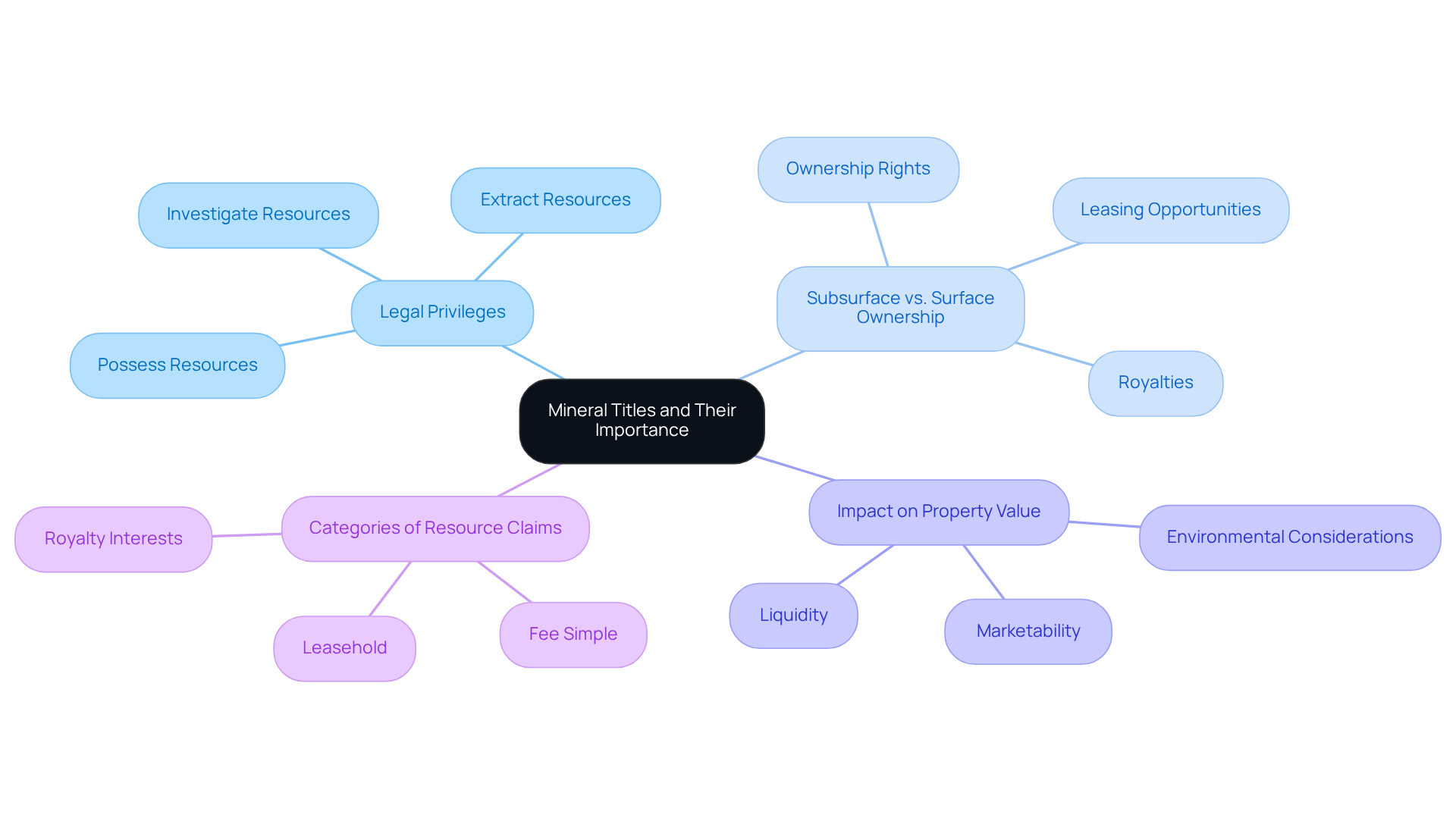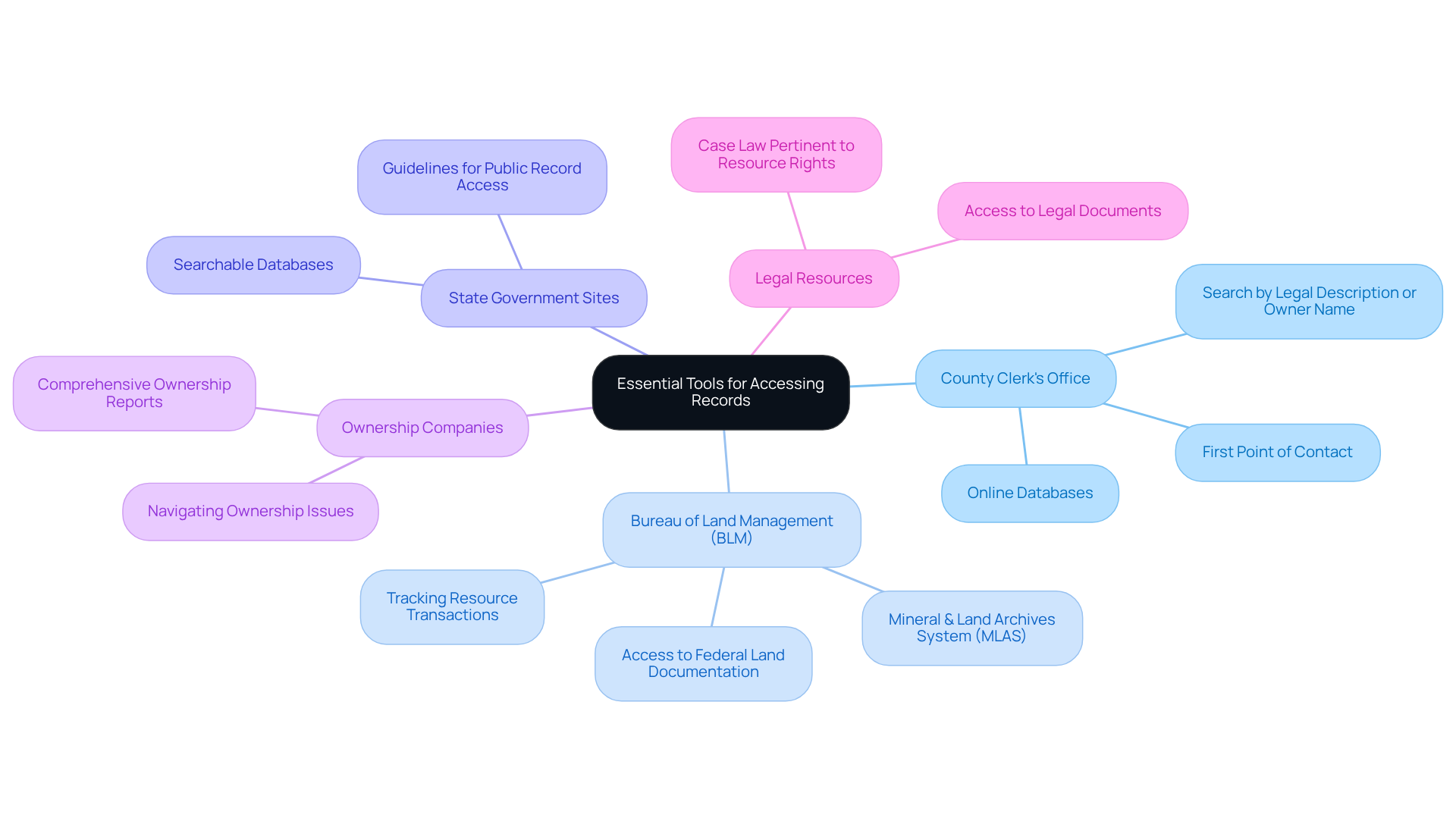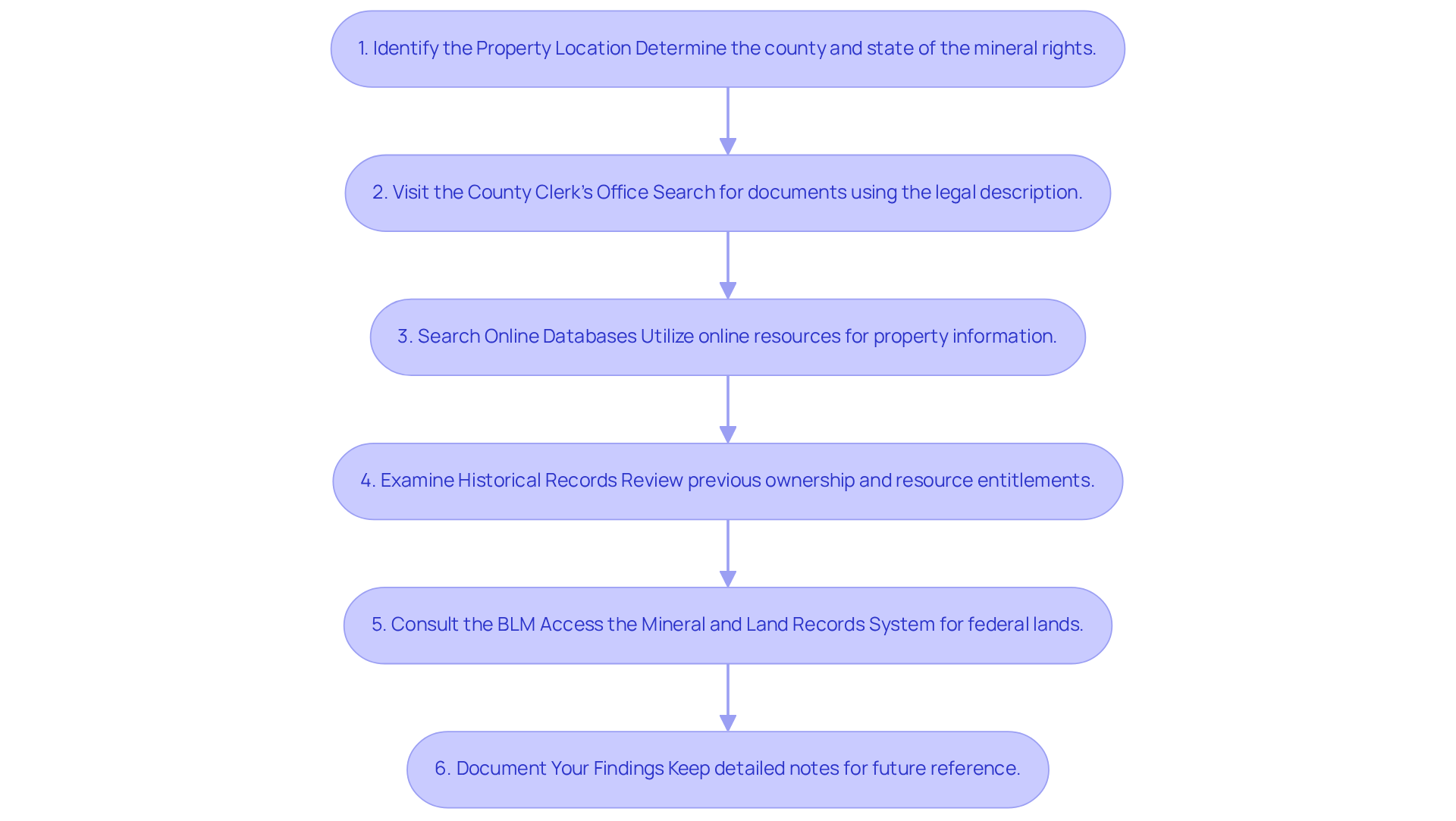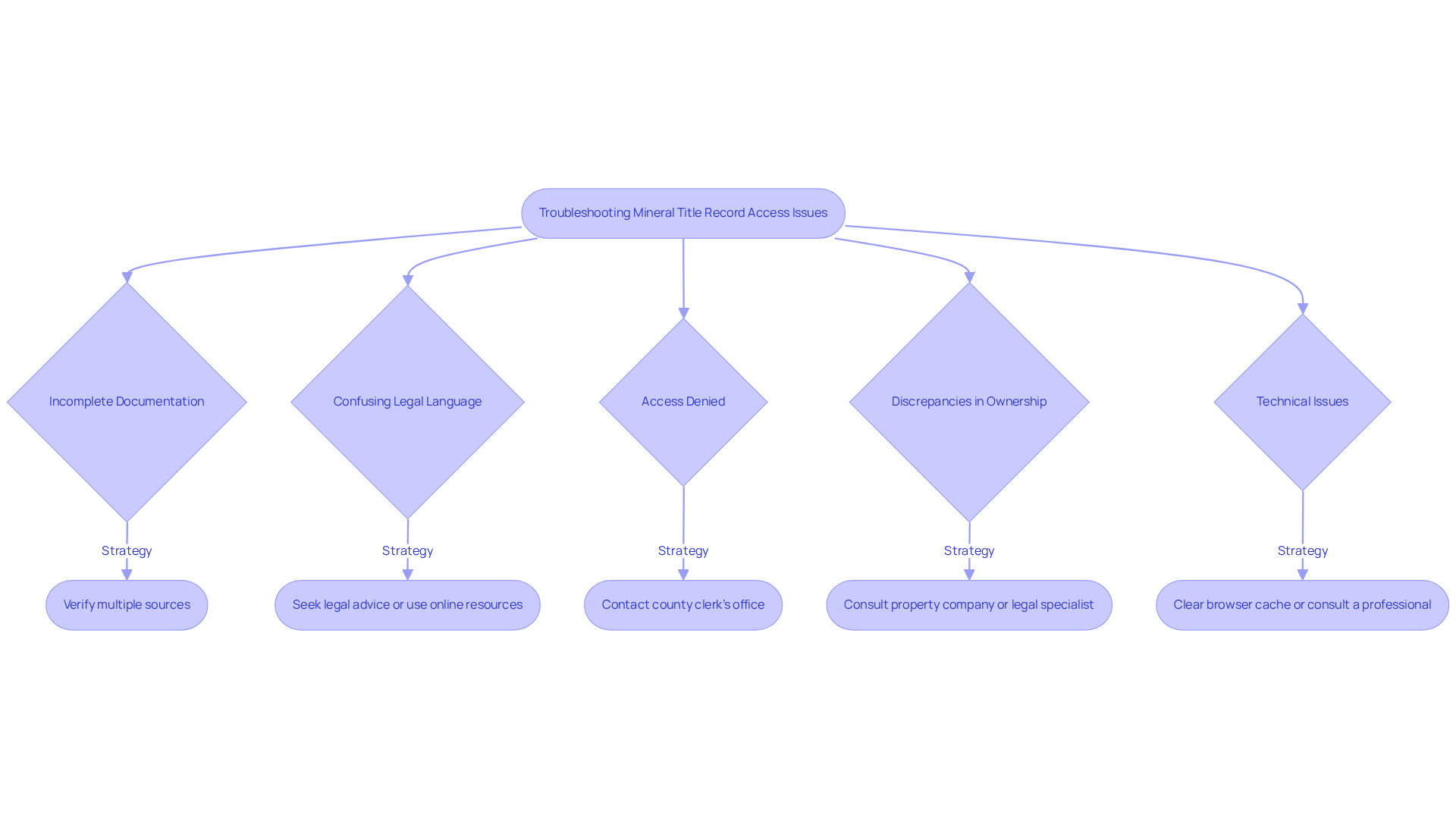Overview
The article outlines a four-step process to master public record access for mineral titles, highlighting the significance of understanding mineral claims and leveraging essential resources. It details specific tools, such as county clerk’s offices and the Bureau of Land Management, and provides step-by-step procedures alongside troubleshooting strategies. This comprehensive approach equips readers to effectively navigate the complexities of mineral title documentation.
Introduction
Understanding mineral titles is crucial for anyone navigating the complexities of real estate; these legal rights can significantly influence property value and ownership. This guide presents a clear, step-by-step approach to mastering public record access for mineral titles, empowering readers to make informed decisions in their real estate endeavors.
However, given the intricacies involved, what common pitfalls could derail the search for these vital documents, and how can they be effectively overcome?
Understand Mineral Titles and Their Importance
Mineral claims refer to the legal privileges to investigate, extract, and possess resources located beneath a specific area of land. Understanding these designations is essential for anyone involved in real estate, as they can significantly impact property value and ownership rights. Notably, subsurface ownership may differ from surface ownership, meaning that owning land does not automatically grant ownership of the resources beneath it. This distinction is vital for landowners and prospective buyers, as it influences leasing opportunities, royalties, and legal obligations.
Familiarizing yourself with the categories of resource claims—such as fee simple, leasehold, and royalty interests—will aid you in navigating the complexities of resource ownership and ensure informed decision-making in real estate transactions.

Gather Essential Tools and Resources for Accessing Records
Obtaining public record access for mineral titles requires a strategic approach and the right resources. To streamline your search, consider the following essential tools:
- County Clerk's Office: Typically, this is the first point of contact for resource ownership documents. Many counties now offer online databases that enhance public record access for mineral titles by allowing searches by legal description or owner name, significantly improving accessibility and efficiency.
- Bureau of Land Management (BLM): The BLM's Mineral & Land Archives System (MLAS) provides extensive access to federal land documentation, including resource entitlements. This platform is invaluable for tracking and mapping resource transactions across jurisdictions.
- State Government Sites: These offer numerous resources for resource ownership, including searchable databases and guidelines that promote public record access for mineral titles.
- Ownership Companies: Engaging with ownership companies can yield comprehensive reports on resource ownership and assist in navigating complex ownership issues, ensuring that all facets of ownership are thoroughly examined.
- Legal Resources: Platforms such as LexisNexis and Westlaw grant access to legal documents and case law pertinent to resource rights, which can be crucial for resolving ownership disputes and understanding the legal landscape.
Utilizing these resources will significantly enhance your ability to conduct thorough and effective inquiries for property documentation, ultimately supporting informed decisions in real estate transactions.

Follow Step-by-Step Procedures to Access Public Records
To access public records for mineral titles, follow these step-by-step procedures:
-
Identify the Property Location: Begin by determining the county and state where the mineral rights are situated. This foundational information is essential for directing your search effectively.
-
Visit the County Clerk's Office: Initiate your search at the local county clerk's office, either in person or online. Utilize the legal description of the property, which usually includes township, range, and section details, to find the pertinent documents.
-
Search Online Databases: If available, leverage online databases provided by the county or state government. Numerous Texas counties provide online access to property information, simplifying this process. Enter the property information to reveal ownership documents, deeds, and any related resources.
-
Examine Historical Records: Explore historical documents that may illuminate previous ownership and any transfers of resource entitlements. This review can clarify discrepancies in ownership and establish a complete chain of property rights, which is crucial for accurate ownership determination. As Nixon Daughtrey highlights, determining ownership of resources necessitates thorough examination of property documentation and ownership history.
-
Consult the BLM: For resource rights linked to federal lands, access the Bureau of Land Management's (BLM) Mineral and Land Records System (MLRS) to find additional documents related to resource rights. This platform provides valuable insights into leases and claims.
-
Document Your Findings: Maintain detailed notes of your findings, including dates, document numbers, and any pertinent information. This documentation will be invaluable for future reference or in the event of disputes. Remember, an average tract of land in America changes hands every 7 years, highlighting the importance of timely research.
By following these steps, you can effectively manage the intricacies of obtaining public record access for mineral titles, ensuring a comprehensive understanding of ownership and possible concerns.

Troubleshoot Common Issues in Accessing Mineral Title Records
Accessing mineral title documents through public record access for mineral titles can present several challenges. To effectively navigate these common issues, consider the following troubleshooting strategies:
-
Incomplete Documentation: Insufficient or absent documents are common barriers. It is advisable to verify multiple sources, encompassing both online databases and physical archives, as information may be scattered across various locations. Every transfer of resource entitlements must be validated to guarantee proper implementation and the absence of unresolved claims. Research indicates that a considerable portion of resource title records may be incomplete, necessitating a thorough search strategy.
-
Confusing Legal Language: The legal terminology in documents can often be perplexing. To mitigate confusion, consider seeking advice from a legal professional or utilizing online resources that elucidate common legal terminology related to resource ownership. Understanding the distinctions between surface and mineral entitlements is essential for accurately interpreting ownership and privileges, as emphasized by experts in the field.
-
Access Denied: If you encounter restrictions when attempting to access certain records, it is prudent to reach out directly to the county clerk's office. They can provide vital assistance in securing the necessary permissions or access privileges, ensuring that your research can proceed unimpeded.
-
Discrepancies in Ownership: Conflicting information regarding ownership can complicate your search. In such cases, gather all pertinent documents and consult a property company or legal specialist to address these discrepancies. As Nixon Daughtrey noted, "Among the most frequent obstacles are ownership concerns related to resource rights." Engaging professionals can clarify ownership issues and streamline the resolution process.
-
Technical Issues: Technical difficulties with online databases can hinder your progress. If you experience issues, attempt clearing your browser cache or switching to a different browser. Should problems persist, consider consulting a professional landman or attorney for assistance, as they can offer valuable insights into navigating these challenges.
By anticipating these common challenges and employing these strategies, you can enhance your search efficiency and improve your chances of successfully achieving public record access for mineral titles. Additionally, referencing case studies, such as the importance of identifying the property and its legal description, can further illustrate the complexities involved in title searches.

Conclusion
Understanding the intricacies of mineral titles and their public records is crucial for anyone involved in real estate or resource management. This guide has outlined essential steps and resources that empower individuals to navigate the complexities of mineral title access effectively. By mastering these processes, one can ensure informed decision-making that ultimately protects ownership rights and enhances property value.
The article elaborated on key components such as:
- The importance of distinguishing between surface and subsurface rights
- The necessity of utilizing reliable tools like county clerk offices and state government sites
- The step-by-step procedures for accessing public records
Furthermore, it addressed common challenges one might encounter, such as:
- Incomplete documentation
- Confusing legal terminology
Providing practical solutions to overcome these obstacles.
Embracing the knowledge and resources shared in this guide can facilitate a more efficient and thorough approach to mineral title research. Whether one is a landowner, prospective buyer, or real estate professional, taking proactive steps to understand and access public records can significantly impact the management and valuation of mineral rights. Engaging with these processes not only safeguards individual interests but also contributes to a more transparent and informed real estate landscape.
Frequently Asked Questions
What are mineral claims?
Mineral claims refer to the legal privileges to investigate, extract, and possess resources located beneath a specific area of land.
Why is it important to understand mineral titles?
Understanding mineral titles is essential for anyone involved in real estate because they can significantly impact property value and ownership rights.
How does subsurface ownership differ from surface ownership?
Subsurface ownership may differ from surface ownership, meaning that owning land does not automatically grant ownership of the resources beneath it.
Why is the distinction between subsurface and surface ownership vital?
This distinction is vital for landowners and prospective buyers as it influences leasing opportunities, royalties, and legal obligations.
What categories of resource claims should one be familiar with?
One should be familiar with categories such as fee simple, leasehold, and royalty interests to navigate the complexities of resource ownership.
How can understanding mineral titles aid in real estate transactions?
Familiarizing yourself with mineral titles will ensure informed decision-making in real estate transactions.




